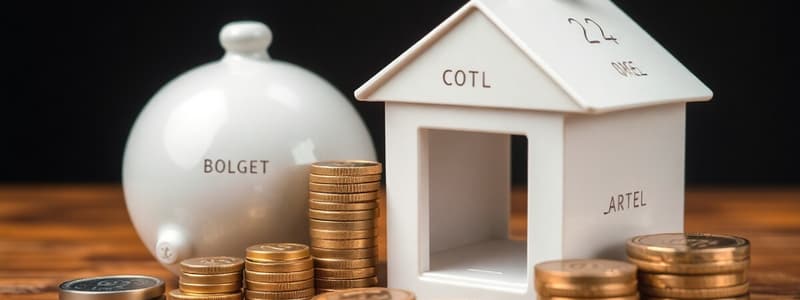Podcast
Questions and Answers
What is the term used to describe all possible combinations of goods that someone can afford, given their budget and the prices of the goods?
What is the term used to describe all possible combinations of goods that someone can afford, given their budget and the prices of the goods?
- Budget constraint
- Scarcity
- Opportunity set (correct)
- Production possibilities frontier
A budget constraint is a straight line, indicating a constant opportunity cost for the goods.
A budget constraint is a straight line, indicating a constant opportunity cost for the goods.
False (B)
What does the slope of a budget constraint represent?
What does the slope of a budget constraint represent?
The relative price of the two goods
The ______ is the set of all possible consumption combinations that an individual can afford, given their budget and the prices of the goods.
The ______ is the set of all possible consumption combinations that an individual can afford, given their budget and the prices of the goods.
Match the following terms with their definitions:
Match the following terms with their definitions:
What does opportunity cost represent?
What does opportunity cost represent?
Every choice made has an associated opportunity cost.
Every choice made has an associated opportunity cost.
What would be the opportunity cost for Alphonso if he chooses to buy a burger?
What would be the opportunity cost for Alphonso if he chooses to buy a burger?
The opportunity cost of attending college includes not only tuition but also _____ and potential earnings lost during study time.
The opportunity cost of attending college includes not only tuition but also _____ and potential earnings lost during study time.
Which of the following would not be considered an opportunity cost?
Which of the following would not be considered an opportunity cost?
Match the following examples with their opportunity costs:
Match the following examples with their opportunity costs:
What are two types of costs associated with attending college?
What are two types of costs associated with attending college?
What happens when a society wants to gain more education according to the production possibilities frontier?
What happens when a society wants to gain more education according to the production possibilities frontier?
The production possibilities frontier indicates that resources can be devoted to both healthcare and education simultaneously without tradeoffs.
The production possibilities frontier indicates that resources can be devoted to both healthcare and education simultaneously without tradeoffs.
What does the law of diminishing returns imply in the context of the PPF?
What does the law of diminishing returns imply in the context of the PPF?
The PPF shows that resources must be __________ to achieve more of either healthcare or education.
The PPF shows that resources must be __________ to achieve more of either healthcare or education.
Match the following points on the production possibilities frontier to their descriptions:
Match the following points on the production possibilities frontier to their descriptions:
Which of the following indicates the PPF behavior when more resources are applied to education?
Which of the following indicates the PPF behavior when more resources are applied to education?
It is possible for a society to produce outside the production possibilities frontier with existing resources.
It is possible for a society to produce outside the production possibilities frontier with existing resources.
Describe what happens to original gains when additional resources are allocated to healthcare.
Describe what happens to original gains when additional resources are allocated to healthcare.
The curvature of the PPF can be explained by the law of __________.
The curvature of the PPF can be explained by the law of __________.
What shape is the budget constraint typically represented as?
What shape is the budget constraint typically represented as?
The PPF has specific numerical values on its axes.
The PPF has specific numerical values on its axes.
Define productive efficiency.
Define productive efficiency.
Both the budget constraint and the PPF illustrate the tradeoff in choosing more of one good at the cost of less of the __________.
Both the budget constraint and the PPF illustrate the tradeoff in choosing more of one good at the cost of less of the __________.
Match the terms with their definitions:
Match the terms with their definitions:
Which of the following statements is true about the shape of the PPF?
Which of the following statements is true about the shape of the PPF?
Allocative efficiency is achieved when resources are allocated to produce more of a good that consumers desire.
Allocative efficiency is achieved when resources are allocated to produce more of a good that consumers desire.
What is the law of diminishing returns?
What is the law of diminishing returns?
A choice inside the PPF is considered to be __________.
A choice inside the PPF is considered to be __________.
Flashcards
Budget Constraint
Budget Constraint
The limit on the consumption choices of an individual based on their income and the prices of goods.
Opportunity Set
Opportunity Set
All possible combinations of goods that a consumer can purchase within their budget constraint.
Slope of Budget Constraint
Slope of Budget Constraint
The rate at which one good can be substituted for another, determined by their prices.
Trade-offs
Trade-offs
Signup and view all the flashcards
Consumption Combination
Consumption Combination
Signup and view all the flashcards
Opportunity Cost
Opportunity Cost
Signup and view all the flashcards
Affordability
Affordability
Signup and view all the flashcards
Next Best Alternative
Next Best Alternative
Signup and view all the flashcards
Out-of-Pocket Costs
Out-of-Pocket Costs
Signup and view all the flashcards
Economic Principles
Economic Principles
Signup and view all the flashcards
Example of Opportunity Cost
Example of Opportunity Cost
Signup and view all the flashcards
Cost of Education
Cost of Education
Signup and view all the flashcards
Production Possibilities Frontier (PPF)
Production Possibilities Frontier (PPF)
Signup and view all the flashcards
Difference in Shape
Difference in Shape
Signup and view all the flashcards
Diminishing Returns
Diminishing Returns
Signup and view all the flashcards
Productive Efficiency
Productive Efficiency
Signup and view all the flashcards
Allocative Efficiency
Allocative Efficiency
Signup and view all the flashcards
Similarities of Budget Constraint and PPF
Similarities of Budget Constraint and PPF
Signup and view all the flashcards
Axes of the PPF
Axes of the PPF
Signup and view all the flashcards
Downward Sloping PPF
Downward Sloping PPF
Signup and view all the flashcards
Curvature of the PPF
Curvature of the PPF
Signup and view all the flashcards
Law of Diminishing Returns
Law of Diminishing Returns
Signup and view all the flashcards
Healthcare vs Education
Healthcare vs Education
Signup and view all the flashcards
Resource Allocation
Resource Allocation
Signup and view all the flashcards
Marginal Utility
Marginal Utility
Signup and view all the flashcards
Study Notes
Principles of Economics 2e - Chapter 2: Choice in a World of Scarcity
-
Chapter Outline: Covers how individuals make choices, the production possibilities frontier (PPF) and social choices, and objections to the economic approach
-
2.1 Individual Choices and Budget Constraints:
- Budget Constraint: All possible combinations of goods that one can afford given prices and income
- Opportunity Set: All possible consumption combinations
- Budget constraints show tradeoffs faced by individuals; with limited income, choosing one good means forgoing another.
-
2.1 Budget Constraints:
- Each point on the constraint represents a combination of burgers and bus tickets that use up the total budget
- The slope of the constraint is determined by the relative price of each good
- Giving up one burger allows the purchase of four bus tickets
- Points outside the constraint are unattainable given the budget
- Each point on the constraint represents a combination of burgers and bus tickets that use up the total budget
-
2.1 Opportunity Cost:
- The cost of one item is the lost opportunity to consume something else
- The value of the next best alternative
- A fundamental principle of economics: every choice has an opportunity cost.
- For Alphonso, the opportunity of a burger is forgoing four bus tickets.
-
2.1 Identifying Opportunity Cost: In many cases, it's reasonable to refer to opportunity cost as the price.
- A non-dollar example is attending college.
- Costs include tuition, books, and other out-of-pocket costs
- Opportunity cost is the value of the next best alternative—what you miss out on by attending college.
- A non-dollar example is attending college.
-
2.1 Opportunity Cost Examples:
- Buying vs. leasing a vehicle
- Different investments (e.g., savings accounts, certificates of deposit)
- Eating out vs. cooking at home
- Walking vs. taking public transportation
- Example Question: What are the opportunity costs of…
-
2.1 Marginal Decision-Making and Diminishing Marginal Utility:
- Marginal Analysis: Examining the benefits and costs of small choices
- Utility: Satisfaction or value from consuming goods
- Law of Diminishing Marginal Utility: Satisfaction decreases as more of a good is consumed (e.g., the first slice of pizza is more satisfying than the tenth).
-
2.1 Sunk Costs:
- Costs incurred in the past that cannot be recovered.
- The lesson of sunk costs: ignore past errors and make decisions based on future possibilities
-
2.2 Production Possibilities Frontier (PPF):
- A diagram showing possible combinations of products based on available resources
- The slope represents the opportunity cost
- PPF shows tradeoffs that firms/societies face when making decisions about production
-
Healthcare vs. Education Production Possibilities Frontier:
- A PPF graph plots healthcare against education, illustrating a tradeoff.
- In the given example:
- Choices like A mean only healthcare; B and C mean most resources go to healthcare
- D and F mean education; moving along the curved line demonstrates how the choice of one good depends on the other
- Societies cannot produce outside the PPF.
- A PPF is downward sloping, meaning obtaining more of one good requires reducing the production of another.
- A PPF graph plots healthcare against education, illustrating a tradeoff.
-
2.2 Shape of PPF and Law of Diminishing Returns:
- Law of Diminishing Returns: Increased inputs for one good decrease returns for the other good, thus resulting in declining slope for PPF graph over time.
-
2.2 Productive and Allocative Efficiency:
- Productive Efficiency: Impossible to produce more of one good without decreasing the output of another good
- Allocative Efficiency: Producing the mix of goods that society most desires
- At each point on the PPF, productive efficiency is achieved but allocative efficiency may not be.
-
2.2 PPF and Comparative Advantage:
- Countries have varying opportunity costs of producing goods.
- Comparative Advantage: When a country can produce a good at a lower opportunity cost than another country.
- Example: Comparing the US and Brazil—comparing their ability to produce wheat and sugar based on their PPF
-
2.3 Confronting Objections to the Economic Approach:
-
Objections in understanding the economic approach to decision making:
- People, firms, and societies do not always act in fundamentally rational ways.
-
Economics approach
- Portrays people as self-interested
- Seeks to describe economic behavior as it actually exists
- Uses positive statements
- Tries to avoid normative statements
-
-
2.3 Objections to the Economic Approach (cont'd):
- Invisible Hand: Suggests that individual self-interest can lead to broader social benefits.
-
Conclusion:
- The chapter highlights the fundamental concepts of scarcity, choice, trade-offs, and opportunity cost.
Studying That Suits You
Use AI to generate personalized quizzes and flashcards to suit your learning preferences.



